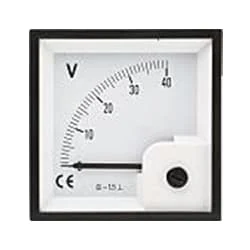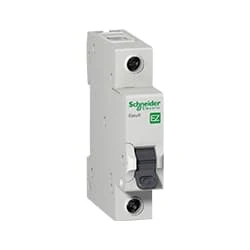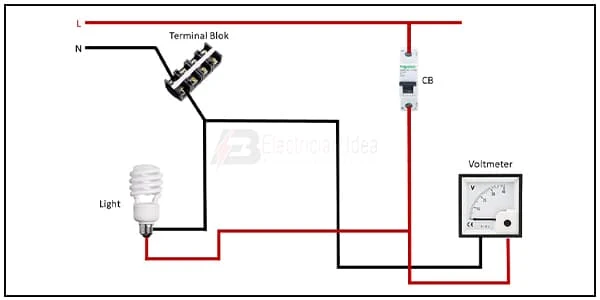Install voltmeter wiring:
This diagram shows how to make an Install Voltmeter wiring diagram. Voltmeter wiring diagram. In this circuit, we use a terminal block, a CFL Light, an SP MCB ( Single Pole Miniature Circuit Breaker ), and a voltmeter. This circuit is very simple and easy to make this circuit. If you want to know more about this circuit please stay with our website and check our youtube video below the post.
Diagram of voltmeter wiring:
Components Need for this Project:
You can get the components from any of the sites below:
- Voltmeter [See Buy Click Amazon]
- SP MCB [See Buy Click Amazon]
- Terminal Block [See Buy Click Amazon]
- Light [See Buy Click Amazon]
Read Also:
Components used to make the voltmeter wiring:
01. Voltmeter
 |
| Fig 2: Voltmeter |
An instrument that measures the potential difference between any two points in a circuit directly in volts is called a voltmeter. To Measure the Potential Difference Between two Points in the Circuit, the Voltmeter Should be Connected in Parallel with those two points. The working common volt meter and ammeter are similar and work on the same principle. Current flows through the coil of the voltmeter at a rate proportional to the voltage and the reading are obtained. The internal resistance of this meter is very high. The coil of a volt meter is made up of many strands of thin wire.
02. SP MCB
 |
| Fig 3: SP MCB |
MCB SP means single pole it protects only one phase switching. MCB (Miniature Circuit Breaker) Curswitch is the most basic general-purpose switch that you use to control a light or another device from one location. These Switches Have Two Brass-Colored Screw Terminals Connected to the hot Power Source Wires. (MCB) For any Distribution Board, the Protection System Must be Used in The Incomer. Phase and Neutral Single Phase Supply to break. 120-volt circuits, 15-20 amp single pole breaker is typically used.
03. Terminal Block
 |
| Fig 4: Terminal Block |
A Terminal Block Consists of Modular Housing With An Insulated Body That Secures Two Or More Wires Together. Terminal Blocks—Also Referred to as terminal Connectors, Connection Terminals, or Screw Terminals—are Used in a Wide Array of Applications Where Electrical Systems Need to be Safely Connected. Electrical Terminals are a Class of Electrical Connectors That are Used to Transfer Electrical Current From a Power or Grounding Source to use. Terminals "Terminate" by Crimping or Soldering to Wire or Cable.
04. Light
 |
| Fig 5: Light |
CFLs work in a completely different way from ordinary lamps, they work by using a different process called fluorescence rather than generating light from heat. A typical light bulb wastes 90% of energy and converts only 10% of energy into light, this is where CFL has the biggest advantage. CFL- Curved or conical glass tube filled with argon and a small amount of mercury vapor. The inner wall of the glass is coated with fluorescent material. CFL- It is manufactured using the principle of creating fluorescent light. CFL- Originally white in color but now the construction and use of CFLs producing colored light has become popular.
Thank You for visiting the website. Keep visiting for more Updates.
Frequently Asked Questions
The voltmeter is shown in a circuit diagram as a V in a circle power supply, and it acts as another resistor Circuit diagram. To prevent the voltmeter from changing the current in the circuit diagram(and therefore the voltage across the power supply resistor), as the voltmeter must have a resistance much larger than that of the resistor.
A measuring tool called a voltmeter is used to determine the voltage between any two locations on an electric circuit. The Permanent Magnet Moving Coil ( P M M C ) galvanometer can function as a voltmeter if a resistor is connected in series with it.
It is an instrument used to measure the potential difference across two terminals in a circuit. It can measure the voltage of the order of millivolts to the order of kilovolts. It is connected in parallel to the source across which the voltage is to be measured.
A Voltmeter has very high resistance to ensure that its connection does not alter the flow of current in the circuit. Now if it is connected in series then no current will be there in the circuit due to its high resistance. Hence it is connected in parallel to the load across which the potential difference is to be measured.
Connect the black (negative) lead of the voltmeter to the negative terminal of the power supply battery. Turn on the power to the circuit or device and observe the voltmeter and reading. Remember to handle the battery and voltmeter with care and follow safety precautions when working with electrical equipment.


Post a Comment
Do leave your comments